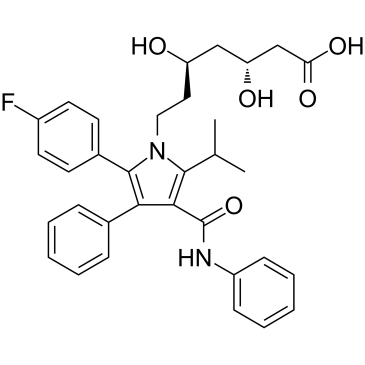Atorvastatin |
| Catalog No.GC35419 |
Atorvastatin is an orally active HMG-CoA reductase inhibitor, has the ability to effectively decrease blood lipids[1].
Products are for research use only. Not for human use. We do not sell to patients.

Cas No.: 134523-00-5
Sample solution is provided at 25 µL, 10mM.
Atorvastatin is an orally active HMG-CoA reductase inhibitor, has the ability to effectively decrease blood lipids[1]. Atorvastatin inhibits human SV-SMC proliferation and invasion with IC50s of 0.39 µM and 2.39 mM.
PMA-differentiated THP-1 cells were used as surrogate microglial cells, and LPS was used to induce inflammatory conditions. Pretreatment with atorvastatin was able to significantly reduce LPS-induced interleukin (IL)-1β and tumour necrosis factor (TNF)-α release, as well as decrease LPS-induced prostaglandin E2 (PGE2). Similarly, global reactive oxygen species (ROS) and nitric oxide (NO) production were decreased following pretreatment with atorvastatin[5]. In rat NP cells, Atorvastatin might suppress matrix degradation induced by TNF-α by suppressing NLRP3 inflammasome activity and inducing autophagic flux. Moreover, atorvastatin suppressed NF-κB signaling induced by TNF-α. NF-κB signaling inhibition suppressed NLRP3 inflammasome activity, and NLRP3 inhibition suppressed NF-κB signaling activation induced by TNF-α. NLRP3 inhibition or NLRP3 knockdown induced autophagic flux in the presence of TNF-α[7].
In mice, Atorvastatin pretreatment promoted increased cell viability after OGD and reoxygenation of hippocampal slices. Atorvastatin-induced neuroprotection may be related to diminished oxidative stress, since it prevented OGD-induced decrement of non-proteic thiols (NPSH) levels and increase in the production of reactive oxygen species (ROS)[3]. The oral treatment with atorvastatin (10mg/kg/day)was able to prevent short-term memory impairments and depressive-like behavior of rats assessed in the social recognition and forced swimming tests at 7 and 14 days, respectively, after a single intranasal administration of 1-methyl-4-phenyl-1,2,3,6-tetrahydropyridine (MPTP) (1mg/nostril)[4].The effects of atorvastatin antidepressants are related to the regulation of serotonergic transmission, the inhibition of NMDA receptor and NO-CGMP synthesis, and the activation of receptor γ dependent on peroxisome proliferators[6]. Atorvastatin treatment exerted neuroprotective effects against LPS-induced depressive-like behaviour which may be related to reduction of TNF-α release, oxidative stress and modulation of BDNF expression[2].
References:
[1]: Taciak PP, Lysenko N, et,al. Drugs which influence serotonin transporter and serotonergic receptors: Pharmacological and clinical properties in the treatment of depression. Pharmacol Rep. 2018 Feb;70(1):37-46. doi: 10.1016/j.pharep.2017.07.011. Epub 2017 Jul 16. PMID: 29309998.
[2]: Taniguti EH, Ferreira YS, et,al. Atorvastatin prevents lipopolysaccharide-induced depressive-like behaviour in mice. Brain Res Bull. 2019 Mar;146:279-286. doi: 10.1016/j.brainresbull.2019.01.018. Epub 2019 Jan 25. PMID: 30690060.
[3]: Vandresen-Filho S, Martins WC, et,al. Atorvastatin prevents cell damage via modulation of oxidative stress, glutamate uptake and glutamine synthetase activity in hippocampal slices subjected to oxygen/glucose deprivation. Neurochem Int. 2013 Jun;62(7):948-55. doi: 10.1016/j.neuint.2013.03.002. Epub 2013 Mar 14. PMID: 23500607.
[4]: Castro AA, Wiemes BP, et,al. Atorvastatin improves cognitive, emotional and motor impairments induced by intranasal 1-methyl-4-phenyl-1,2,3,6-tetrahydropyridine (MPTP) administration in rats, an experimental model of Parkinson's disease. Brain Res. 2013 Jun 4;1513:103-16. doi: 10.1016/j.brainres.2013.03.029. Epub 2013 Mar 30. PMID: 23548600.
[5]: McFarland AJ, Davey AK, et,al. Statins Reduce Lipopolysaccharide-Induced Cytokine and Inflammatory Mediator Release in an In Vitro Model of Microglial-Like Cells. Mediators Inflamm. 2017;2017:2582745. doi: 10.1155/2017/2582745. Epub 2017 May 4. PMID: 28546657; PMCID: PMC5435995.
[6]: Ludka FK, Constantino LC, et,al. Atorvastatin evokes a serotonergic system-dependent antidepressant-like effect in mice. Pharmacol Biochem Behav. 2014 Jul;122:253-60. doi: 10.1016/j.pbb.2014.04.005. Epub 2014 Apr 21. PMID: 24769309.
[7]: Chen J, Yan J, et,al.Atorvastatin inhibited TNF-α induced matrix degradation in rat nucleus pulposus cells by suppressing NLRP3 inflammasome activity and inducing autophagy through NF-κB signaling. Cell Cycle. 2021 Oct;20(20):2160-2173. doi: 10.1080/15384101.2021.1973707. Epub 2021 Sep 8. PMID: 34494933; PMCID: PMC8565837.
Average Rating: 5 (Based on Reviews and 25 reference(s) in Google Scholar.)
GLPBIO products are for RESEARCH USE ONLY. Please make sure your review or question is research based.
Required fields are marked with *




